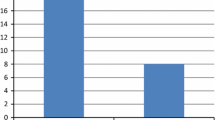Abstract
Purpose
A sliding inguinal hernia is defined as a hernia where part of the hernial sac wall is formed by an organ, e.g., the colon or bladder. Thus, repair of a sliding inguinal hernia may have higher risk of complications and recurrence compared with non-sliding inguinal hernia. The aim of this study was to investigate the incidence and reoperation rates following sliding inguinal hernia repair.
Methods
This study was based on data from the Danish Hernia Database covering the period between January 1, 1998 and February 22, 2012. Data were collected prospectively and nationwide.
Results
In total, 70,091 primary hernia repairs were included for analysis. The occurrence of sliding inguinal hernias of the total group of included hernia repairs was 9.4 % among males and 2.9 % among females (p < 0.05). Among male patients, the sliding inguinal hernias had a higher cumulated reoperation rate compared with non-sliding inguinal hernias (6.0 versus 4.2 %, log-rank p = 0.001). A Cox regression model was fitted and showed that the type of repair affected the risk for reoperation for recurrence; hazard ratio (95 % confidence interval): open non-mesh: reference, Lichtenstein 0.43 (0.39–0.48), other open mesh 0.46 (0.39–0.54), laparoscopic 0.70 (0.60–0.84).
Conclusion
The incidence of sliding inguinal hernia is higher in males than in females, and sliding inguinal hernia is a risk factor for reoperation for recurrence. The Lichtenstein repair could be considered over the laparoscopic approach because of lower reoperation rates.



Similar content being viewed by others
References
Francis DMA, Hernias (2006) In: Tjandra JJ, Glunie GJA, Kaye AH et al (eds) Textbook of surgery. Blackwell, Oxford, pp 345–359
Sensenig DM, Nichols JB (1955) Sliding hernias: a follow-up study. AMA Arch Surg 71:756–760
Komorowski AL, Moran-Rodriguez J, Kazi R, Wysocki WM (2012) Sliding inguinal hernias. Int J Surg 10:206–208
Adams RA, Wysocki AP (2010) Outcome of sliding inguinal hernia repair. Hernia 14:47–49
Ryan EA (1956) An analysis of 313 consecutive cases of indirect sliding inguinal hernias. Surg Gynecol Obstet 102:45–58
Gaspar MR, Joergenson EJ, Woolley MM (1956) Sliding indirect inguinal hernia. Calif Med 85:330–334
Bay-Nielsen M, Kehlet H, Strand L, Malmstrøm J, Andersen FH, Wara P, Juul P, Callesen T (2001) Quality assessment of 26,304 herniorrhaphies in Denmark: a prospective nationwide study. Lancet 358:1124–1128
Rosenberg J, Bisgaard T, Kehlet H, Wara P, Asmussen T, Juul P, Strand L, Andersen FH, Bay-Nielsen M (2011) Danish Hernia Database recommendations for the management of inguinal and femoral hernia in adults. Dan Med Bull 58:C4243
Simons MP, Aufenacker T, Bay-Nielsen M, Bouillot JL, Campanelli G, Conze J, de Lange D, Fortelny R, Heikkinen T, Kingsnorth A, Kukleta J, Morales-Conde S, Nordin P, Schumpelick V, Smedberg S, Smietanski M, Weber G, Miserez M (2009) European Hernia Society guidelines on the treatment of inguinal hernia in adult patients. Hernia 13:343–403
Schmedt CG, Sauerland S, Bittner R (2005) Comparison of endoscopic procedures vs Lichtenstein and other open mesh techniques for inguinal hernia repair: a meta-analysis of randomized controlled trials. Surg Endosc 19:188–199
Burcharth J, Andresen K, Pommergaard HC, Bisgaard T, Rosenberg J (2013) Recurrence pattern of direct and indirect inguinal hernias in a nationwide population. Surgery 155:173–177
Glassow F (1965) High ligation of the sac in indirect inguinal hernia. Am J Surg 109:460–463
Delikoukos S, Lavant L, Hlias G, Palogos K, Gikas D (2007) The role of hernia sac ligation in postoperative pain in patients with elective tension-free indirect inguinal hernia repair: a prospective randomized study. Hernia 11:425–428
Bendavid R (2002) Sliding hernias. Hernia 6:137–140
Kald A, Nilsson E, Anderberg B, Bragmark M, Engstrom P, Gunnarsson U, Haapaniemi S, Lindhagen J, Nilsson P, Sandblom G, Stubberod A (1998) Reoperation as surrogate endpoint in hernia surgery. A three year follow-up of 1565 herniorrhaphies. Eur J Surg 164:45–50
Lundstrom KJ, Sandblom G, Smedberg S, Nordin P (2012) Risk factors for complications in groin hernia surgery: a national register study. Ann Surg 255:784–788
Conflicts of interest
KA reports grants from Bard, outside the submitted work.
TB reports personal fees from Bard, grants from Ethicon, grants from Covidien, outside the submitted work.
JR reports grants from Baxter Healthcare, grants from Johnson & Johnson, grants and personal fees from Bard, outside the submitted work.
Authors’ contribution
KA took part in the study conception and design, analysis and interpretation of data, drafting of the manuscript, and critical revision of the manuscript. TB and JR took part in the study conception and design, acquisition of data, analysis and interpretation of data, drafting of the manuscript, and critical revision of the manuscript
Author information
Authors and Affiliations
Corresponding author
Rights and permissions
About this article
Cite this article
Andresen, K., Bisgaard, T. & Rosenberg, J. Sliding inguinal hernia is a risk factor for recurrence. Langenbecks Arch Surg 400, 101–106 (2015). https://doi.org/10.1007/s00423-014-1262-y
Received:
Accepted:
Published:
Issue Date:
DOI: https://doi.org/10.1007/s00423-014-1262-y




